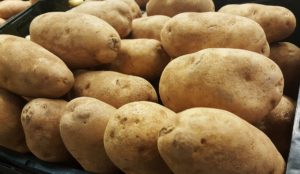From their humble brown beginnings beneath the soil, potatoes have become a staple in the North American diet. They are currently the most consumed vegetable in the US, with a yearly average intake of nearly 50 lbs per person. That means events in the world of the potato affect the lunch bags and dinner plates of a lot of people.
What qualifies as an “event” in the potato world, you might ask? Genetic modification certainly qualifies. Agri-giant J.R. Simplot’s introduction of the “Innate ‘White Russet’” potato in 2014 was a major event. As so often happens, one thing leads to another: Simplot’s creation pushed potatoes onto the Non-GMO Project’s High-Risk list in 2018, meaning there is a “high likelihood of GMO contamination in the conventional and non-GMO supply chain.” When a high-risk crop is used in a product, the Non-GMO Project requires extra scrutiny before allowing verification.
Read more about potatoes joining the high-risk list
Po-tay-to, Po-tah-to
The 1st generation Innate potato was engineered using RNAi, a form of gene silencing. Gene silencing is one of the new genetic engineering techniques the biotech industry argues does not produce GMOs. We, of course, know that argument is absurd: any process in which an organism’s genetic material is engineered in a laboratory is genetic engineering. Calling it by a different name doesn’t change that. Both the European Union and the United Nations agree that products of genetic engineering, new or old, are GMOs. We think most people agree.
Those genes that are being silenced in the potato have evolved over millions of years. Genes are “Life’s Little Instruction Book” for a living thing, be it a person, an animal, or a potato. Genes direct our cells to respond to their environment, improving the chances of a healthy and productive life. For a potato, a healthy and productive life includes things like minimizing tissue damage from injury— responding to injury and disease by producing a substance called melanin to strengthen weakened tissue. Melanin also causes discoloration, providing a visual sign that all is not well with the potato. Silencing this gene doesn’t make the potato stronger or better. It doesn’t prevent injury and disease, it only conceals the evidence of it. And that is a very bad idea.
 The Picture of Mr. Potatohead
The Picture of Mr. Potatohead
The gothic novel, “The Picture of Dorian Gray,” tells the story of a handsome and narcissistic young man who trades his soul to maintain his physical perfection. Once his wish is granted, its power corrupts him: knowing that his exterior will remain unblemished, he dives headfirst into his darkest desires. The passing years bring scandal and misery to those around him. But magic often involves fine print: while he remains flawless, a portrait that was painted of him magically records life’s tolls. With each sinister act, the picture of Dorian Gray grows ever more hideous, chronicling his soul’s decay.
As repugnant as young Dorian Gray would have found any comparison between his lovely self and a potato, the parallel is striking: When a pristine appearance comes at the cost of concealing rot, what damage can be done? The answer, for both Mr. Gray and Mr. Potatohead, is quite a lot.
As ardently as we might wish away an unsightly blemish, when it comes to our food, pigments and spots are full of useful information. They can tell us what is ripe, show symptoms of disease, and alert us to injuries that hasten decomposition. The discoloration that protects weakened tissues is the potato’s version of an orange traffic cone: “Hey, watch it!” it tells us. “GO AROUND!” Based on that data, we decide which bits of food are okay to consume and which are best added to the compost heap. So what happens when those visual cues are removed?
- Handle with care: Because bruising is concealed, genetically engineered potatoes tend to be handled more roughly during harvest and transport than their non-GMO counterparts, according to the Innate potato’s creator, Caius Rommens. Not only do they conceal damage, they conceal a lot more damage. (In his book, “Pandora’s Potatoes: The Worst GMOs,” Rommens outlines the problems of his own invention.)
- Breaching quarantine: Given their popularity, potatoes are picked, packed, and transported in huge quantities. When symptoms of damage are concealed as they are with the Innate potato, damaged and diseased potatoes join the regular supply chain. They carry germs to other farms and into processing plants. These locations become hubs for the reproduction and spread of pathogens.
- What’s that on my plate?: In concealing the evidence of damage, the Innate potato could increase the chance that a potato carrying disease or toxins will make its way into the food we eat. Remember, each bruise a potato endures is a potential entry point for infection. Even a whole GMO potato, peeled and chopped before cooking, could carry damage the consumer can’t see
Do we need to trade unnecessary food waste for unsanitary food use? Food waste is, of course, a huge problem. But consuming food that is damaged because that damage is concealed doesn’t solve the problem, it only creates new ones. According to Dr. Rommens, genetically modified potatoes could harbour toxins in the damaged tissue, which might make some consumers feel very ill indeed. The false perfection of GMO potatoes masks those flaws, which are plain to see in their perfectly imperfect non-GMO counterparts.
One Potato, Two Potato
Potatoes pop up in a lot of different places in the grocery store: whole potatoes in the produce section, in processed frozen foods like french fries and tater tots, and, of course, potato chips. They are also used as additives, such as potato starch that acts as a thickener in a variety of prepared foods. To separate the good from the bad, every ingredient and processing aid derived from a high-risk crop is thoroughly evaluated before Non-GMO Project Verification can happen.
